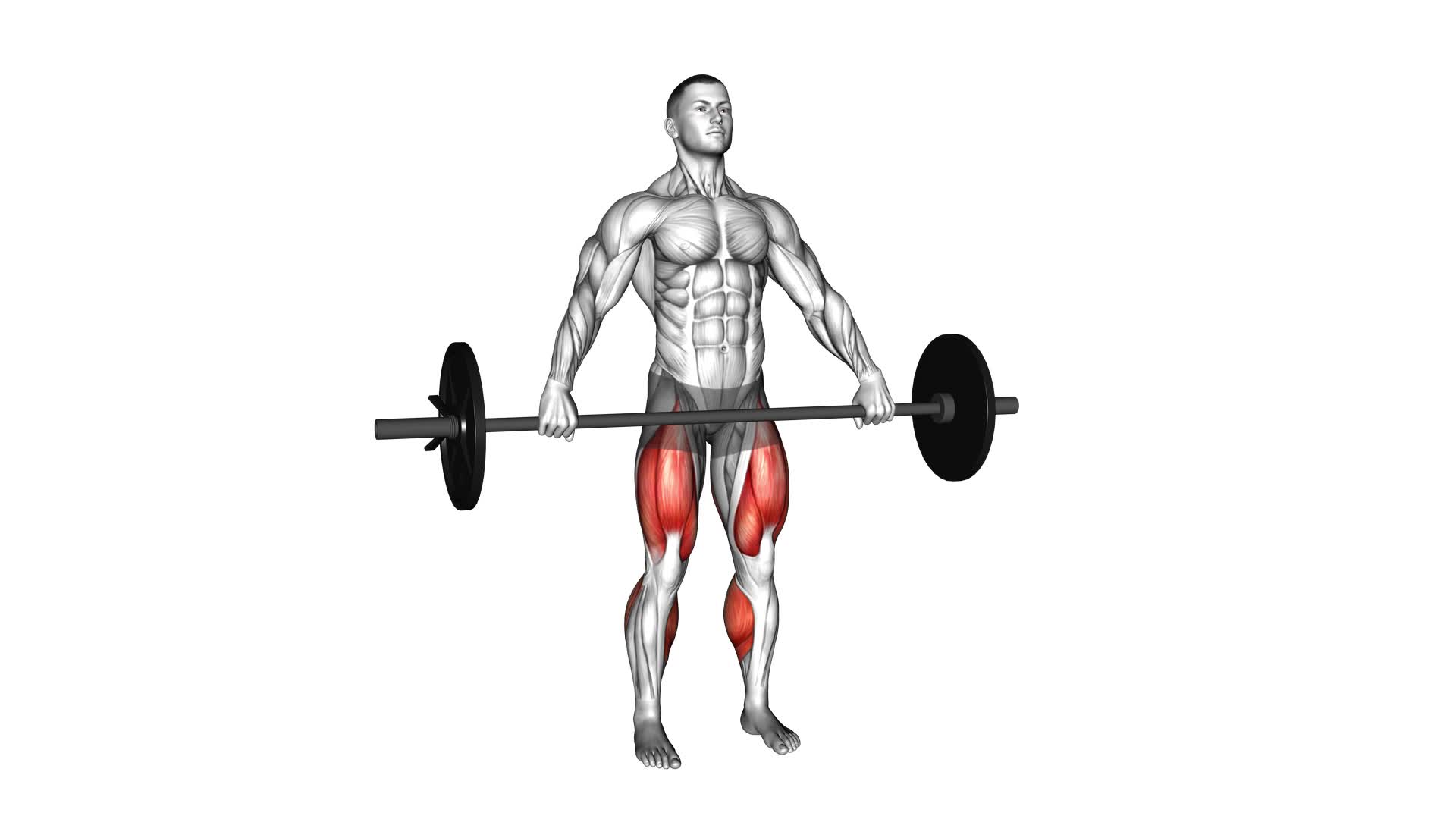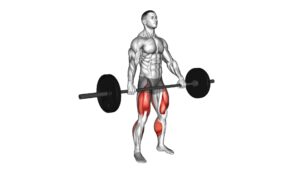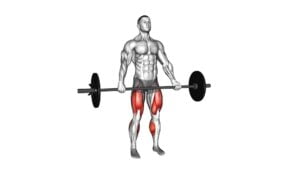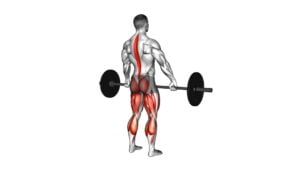Barbell Snatch Grip Deadlift (Male) – Video Exercise Guide & Tips

Are you looking to take your deadlift game to the next level? Then the barbell snatch grip deadlift is the exercise for you.
Watch This Exercise Video
In this video exercise guide, we'll show you the proper set-up and grip technique, as well as the step-by-step execution of the exercise.
We'll also highlight common mistakes to avoid and provide tips for increasing your strength and performance.
Get ready to crush your deadlift goals with this expert-approved exercise.
Let's dive in!
Key Takeaways
- Improved grip strength.
- Increased upper body muscle engagement.
- Comprehensive full-body workout targeting lower body muscles.
- Promotes better posture and spinal alignment for injury prevention.
Benefits of the Barbell Snatch Grip Deadlift
You will experience improved grip strength and increased upper body muscle engagement when performing the Barbell Snatch Grip Deadlift. This exercise is highly effective for muscle activation and injury prevention.
The snatch grip used in this deadlift variation requires you to grip the barbell with a wider hand placement, which activates more muscles in your upper body compared to a regular deadlift. By using a wider grip, you engage the muscles in your shoulders, upper back, and forearms to a greater extent. This increased muscle activation helps to strengthen these areas, leading to improved overall upper body strength and stability.
Additionally, the snatch grip deadlift also targets the muscles in your lower body, including your glutes, hamstrings, and quadriceps, providing a comprehensive full-body workout.
Another benefit of the Barbell Snatch Grip Deadlift is injury prevention. By engaging more muscles and distributing the load more evenly throughout your body, this exercise helps to reduce the risk of injury. The increased upper body muscle engagement also promotes better posture and spinal alignment, which can prevent back pain and other related issues.
Now that you understand the benefits of the Barbell Snatch Grip Deadlift, let's move on to the next section which will cover proper set-up and grip technique.
Proper Set-Up and Grip Technique
To ensure proper execution of the Barbell Snatch Grip Deadlift, focus on achieving optimal alignment and positioning. The set-up and grip technique are crucial for maximizing the benefits of this exercise while minimizing the risk of injury. Here are some key points to keep in mind:
- Common Mistakes:
- Gripping the bar too wide or too narrow can compromise your strength and stability. Aim for a grip that's slightly wider than shoulder-width apart.
- Neglecting to engage your core and maintain a neutral spine can lead to poor form and potential back injuries. Keep your core tight and your back flat throughout the movement.
- Relying too much on your arms and neglecting to engage your legs and hips can limit your strength and power potential. Remember, this exercise is primarily a lower body movement.
- Grip Technique:
- Start with a snatch grip, with your hands wider than shoulder-width apart and palms facing away from you.
- Ensure that your grip is secure but not excessively tight, allowing for fluid movement.
- Make sure to wrap your fingers around the bar, maintaining a firm grip throughout the exercise.
Step-by-Step Execution of the Exercise
How can you effectively execute the Barbell Snatch Grip Deadlift? To perform this exercise, follow the step-by-step execution technique outlined below.
- Begin by standing with your feet shoulder-width apart, toes pointing slightly outward. Position the barbell on the floor in front of you.
- Squat down, bending at the hips and knees, and grip the barbell with a snatch grip. Your hands should be wider than shoulder-width apart, with palms facing towards you.
- Engage your core and lift your chest, maintaining a neutral spine. This will ensure proper form and prevent lower back injuries.
- Drive through your heels and lift the barbell off the floor, extending your hips and knees simultaneously. Keep the barbell close to your body throughout the movement.
- Once you reach a standing position, pause briefly and squeeze your glutes at the top.
- Lower the barbell back to the starting position by reversing the movement, hinging at the hips and bending the knees.
The Barbell Snatch Grip Deadlift primarily targets the muscles in your posterior chain, including your hamstrings, glutes, and lower back. It also engages your quadriceps, calves, and forearms to a lesser extent. Proper execution of this exercise is crucial to maximize muscle activation and minimize the risk of injury.
Common Mistakes to Avoid
To avoid common mistakes, focus on maintaining proper form and technique during the Barbell Snatch Grip Deadlift. This exercise can be highly effective for building strength and power, but only if done correctly. Here are some common mistakes to avoid:
- Rounding your back: One of the most common mistakes is rounding your back during the lift. This puts excessive strain on your spine and increases the risk of injury. Keep your back straight and engage your core throughout the movement.
- Lifting with your arms: Another mistake is relying too much on your arms to lift the barbell. Remember, this is a deadlift exercise, so the power should come from your legs and hips. Use your arms to maintain a secure grip, but let your lower body do the work.
- Lifting too heavy: It's important to start with a weight that you can lift with proper form. Gradually increase the weight as you get stronger and more comfortable with the exercise. Lifting too heavy can lead to compromised form and potential injury.
Tips for Increasing Strength and Performance
Focus on incorporating progressive overload into your training routine to increase strength and enhance performance in the Barbell Snatch Grip Deadlift. Progressive overload is the principle of gradually increasing the stress placed on your muscles over time, which leads to improved strength and muscle growth. To implement this technique, you can increase the weight you lift, the number of repetitions, or the number of sets in each training session. It's important to challenge yourself and aim for incremental improvements to continue making progress.
In addition to progressive overload, there are several powerlifting techniques and muscle building strategies that can help you increase your strength and performance in the Barbell Snatch Grip Deadlift. One effective technique is to focus on proper form and technique. This includes maintaining a neutral spine, engaging your core, and using the correct grip width. Another strategy is to incorporate accessory exercises that target the muscles used in the deadlift, such as Romanian deadlifts, glute bridges, and barbell rows. These exercises can help strengthen your posterior chain and improve your overall deadlift performance.
By incorporating progressive overload, powerlifting techniques, and muscle building strategies into your training routine, you can continually improve your strength and performance in the Barbell Snatch Grip Deadlift.
Now, let's explore some variations and modifications for progression in the next section.
Variations and Modifications for Progression
To progress in the Barbell Snatch Grip Deadlift, try incorporating different variations and modifications. These progression techniques will help you continue to challenge your muscles and improve your strength and performance. Here are some alternative exercises and variations you can try:
- Sumo Deadlift: This variation involves taking a wider stance and gripping the barbell with your hands inside your knees. It targets your glutes and inner thighs more than the traditional deadlift.
- Romanian Deadlift: This variation focuses on the eccentric phase of the movement, where you lower the barbell slowly and with control. It emphasizes the hamstrings and lower back.
- Deficit Deadlift: This variation involves standing on a raised platform or plates, which increases the range of motion and places more emphasis on your posterior chain.
By incorporating these variations into your training routine, you can continue to challenge your muscles and progress in the Barbell Snatch Grip Deadlift.
Remember to start with lighter weights and gradually increase the load as you become more comfortable with each variation. Keep pushing yourself and striving for improvement to achieve your strength and performance goals.
Frequently Asked Questions
How Many Repetitions Should I Do When Performing the Barbell Snatch Grip Deadlift?
When performing the barbell snatch grip deadlift, the number of repetitions you should do depends on your fitness goals and current strength level. To maximize muscle activation and overall strength, aim for 8-12 repetitions per set. This range allows you to challenge your muscles without sacrificing proper form.
Remember to start with a weight that's challenging but manageable, and gradually increase the load as you get stronger.
What Muscles Does the Barbell Snatch Grip Deadlift Primarily Target?
The barbell snatch grip deadlift primarily targets multiple muscles in your body. By performing this exercise, you can benefit from developing strength and power in your posterior chain, including your hamstrings, glutes, and lower back.
Additionally, the snatch grip deadlift engages your upper back and shoulders, helping to improve your posture and overall stability.
There are also variations of this exercise that can target specific muscle groups or add an additional challenge to your workout routine.
Can the Barbell Snatch Grip Deadlift Be Performed With Dumbbells Instead of a Barbell?
Yes, the barbell snatch grip deadlift can be performed with dumbbells instead of a barbell.
This dumbbell variation offers similar benefits to the barbell snatch grip deadlift, such as targeting multiple muscle groups like the hamstrings, glutes, and upper back.
It also helps improve grip strength and overall power.
Just make sure to maintain proper form and control throughout the exercise to maximize its effectiveness.
Is It Necessary to Wear Weightlifting Shoes When Performing the Barbell Snatch Grip Deadlift?
When performing the barbell snatch grip deadlift, you may wonder if it's necessary to wear weightlifting shoes.
Weightlifting shoes offer several benefits for deadlifts, including increased stability and improved ankle mobility. However, they aren't absolutely necessary.
You can still perform the exercise without weightlifting shoes, but keep in mind that using proper footwear can enhance your performance and reduce the risk of injury.
Additionally, there are alternative grip options for the barbell snatch grip deadlift, such as using straps or mixed grip.
Can the Barbell Snatch Grip Deadlift Be Included in My Regular Leg or Back Workout Routine?
Yes, the barbell snatch grip deadlift can definitely be included in your regular leg or back workout routine.
It's a compound exercise that targets multiple muscle groups, including your legs, back, and shoulders.
By incorporating this exercise into your routine, you can enhance your overall strength and power.
Additionally, the snatch grip deadlift helps improve your grip strength and posture.
Conclusion
In conclusion, the barbell snatch grip deadlift is a highly effective exercise for increasing strength and overall performance. By using proper set-up and grip technique, individuals can avoid common mistakes and maximize the benefits of this exercise.
Additionally, there are variations and modifications available for progression, allowing individuals to continually challenge themselves and improve their fitness levels.
Incorporating the barbell snatch grip deadlift into your workout routine can lead to significant gains in strength and overall athletic performance.

Author
Years ago, the spark of my life’s passion ignited in my mind the moment I stepped into the local gym for the first time. The inaugural bead of perspiration, the initial endeavor, the very first surge of endorphins, and a sense of pride that washed over me post-workout marked the beginning of my deep-seated interest in strength sports, fitness, and sports nutrition. This very curiosity blossomed rapidly into a profound fascination, propelling me to earn a Master’s degree in Physical Education from the Academy of Physical Education in Krakow, followed by a Sports Manager diploma from the Jagiellonian University. My journey of growth led me to gain more specialized qualifications, such as being a certified personal trainer with a focus on sports dietetics, a lifeguard, and an instructor for wellness and corrective gymnastics. Theoretical knowledge paired seamlessly with practical experience, reinforcing my belief that the transformation of individuals under my guidance was also a reflection of my personal growth. This belief holds true even today. Each day, I strive to push the boundaries and explore new realms. These realms gently elevate me to greater heights. The unique combination of passion for my field and the continuous quest for growth fuels my drive to break new ground.







